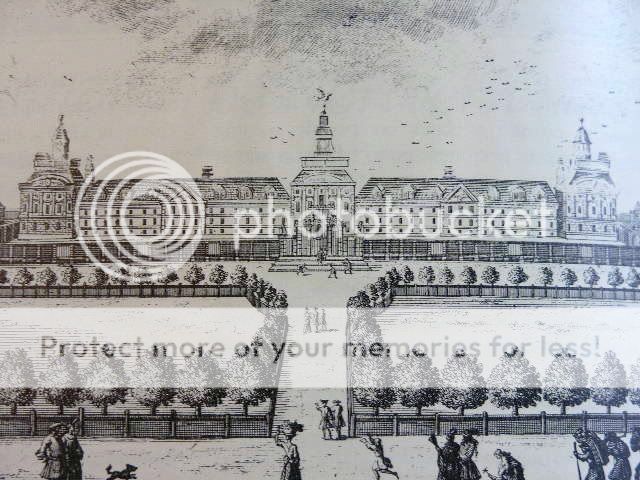This is Bethlem Hospital in Moorgate (above) It moved from its spot on Bishopsgate Street (by current Liverpool Station) to Moorfields in 1675 until a new building was completed in St. George’s Fields, Southwark in 1815 (below). Moorfields housed refugees, poor, and the unsavory of the victims of Great Fire of 1666. It was therefore seen as a prime place to site Bethlem “lunatic asylum”. In the present City of London, remnants of of the streets can still be seen in the Barbican.
The oldest psychiatric hospital, Bethlem, derives its name from the original iteration in 1247. A priory for the sisters and brothers of the Order of the Star of Bethlehem, in 1330 it became a hospital and in 1357 admitted some its first mentally ill patients. By the 16th century, conditions were deplorable and the only treatment was by in large restraint.
In 1725-34, “curable” and “incurable” wards ushered in a new era of psychiatric treatment for patients of Bethlem Royal Hospital, who were commonly diagnosed as morally weak and suffering from “moral insanity.”
It was during the 18th century that Bethlem (or Bedlam) became a reputed hot spot. Myth has it that for a penny (or free on the first Tuesday of the month), visitors could peer into patient cells, laugh at behaviors, and bring long sticks to poke residents.

Modern historians Bynum, Porter and Shepherd dispute this myth as being grossly exaggerated. More likely, donations to the poor box did occur as Bethlem only housed the poor, and most likely the ask was at the end of a tour. Bynum et al also demonstrate that visitor admission was completely stopped in 1774.
Still, “Bedlam” continued to capture the imaginations of writers, poets, and journalists as a sort of purgatory where inner demons tortured victims of moral weakness. No doubt it was images like those popular descriptions of Bethlem Royal Hospital that fed into Victorian ideals…particularly after the excesses of the Regency era.
There is a lot of misinformation about Bethlem Royal Hospital, and while no source has absolved it for its mistreatment and misunderstanding of mental illness, it still does not seem likely that its was open to the public for over fifty years as a zoo-like place.
“The visiting days are two Mondays in each month. The Government pays 15s. a week for each criminal in this hospital. The average change for the pauper lunatic in the county asylums is 7s. a week; and for idiots, or lunatics, in the workhouses, from 2s.10d. to 3s. 6d. a week.
The income of Bethlem and Bridewell Hospitals amounts to £33,000 per annum, and with the exception of £3000 voted by the city of London for the building of the new hospital, the whole is the accumulation of private benevolence!
The number of patients in the hospital at the present time is about 390, of whom 194 are supposed to be incurable, and 85 are criminals.”
from The Illustrated London News, 1843
“
Bethlem Hospital was founded in 1547, and the early treatment of the miserable creatures committed to its brutal rulers, appears to have been characterised by utter indifference to the feelings and comforts of the patients, and a studied aggravation of their miseries. Indeed, to our shame be it recorded, these miseries were made the materials for actual profit to the hospital; a sum of about 400l. being annually collected by exhibiting the poor maniacs, chiefly naked, and uniformly chained to the walls of their dungeons, and by exciting them to the most violent manifestations of their maladies. This practice of showing the patients, like wild beasts, was abolished in 1770, but the abolition was unaccompanied by any other improvement in their treatment. Recently, however, the unfortunate lunatics have been more humanely treated, as will be seen in the following pages.
The Pictorial Handbook of London, 1854
Conclusion? Not a Regency Hot Spot, but definitely a part of its fabric.












How fascinating! I really enjoyed this post; it’s interesting how moral decay was attributed to the insane. Surely, though, Hogarth’s depiction of the posh ladies gawping at the inmates couldn’t have been largely fictionalised, as Bynum, Porter and Shepherd suggest? The 18th century was quite a brutal age…
I think they primarily took issue with the myth that it occurred for years on end, and that the hospital fostered it by charging admission.
The hospital, most scholars agree, deserved its reputation for brutality. Therefore, I think there is some truth to Hogarth’s depiction, but perhaps it also reflects a deeper theme of class separation in Society as a whole. I think its a pretty good representation of aristocratic attitudes generally towards the lower classes. There was definite disdain and a sense of divine or genetic superiority that Hogarth’s work portrays so neatly.
After all, the story of Tom Rakewell is that of a man who gets rich quick, and had his story turned out differently, he still probably would have been spurned by the aristocracy – you only have to look at how David Garrick, a hugely wealthy actor, was treated by the gentry to understand that you could never rise above your low birth, no matter how much money you had!
Too true. Popular statements like “in the blood” and “blood will tell” demonstrate the reigning idea of nature above nurture.
Too true. Popular statements like “in the blood” and “blood will tell” demonstrate the reigning idea of nature above nurture.
By the way, I’ve nominated you for The Excessively Diverting Blog Award. See:
http://mrswoffington.blogspot.com/2009/02/excessively-diverting-blog-award.html
By the way, I’ve nominated you for The Excessively Diverting Blog Award. See:
http://mrswoffington.blogspot.com/2009/02/excessively-diverting-blog-award.html